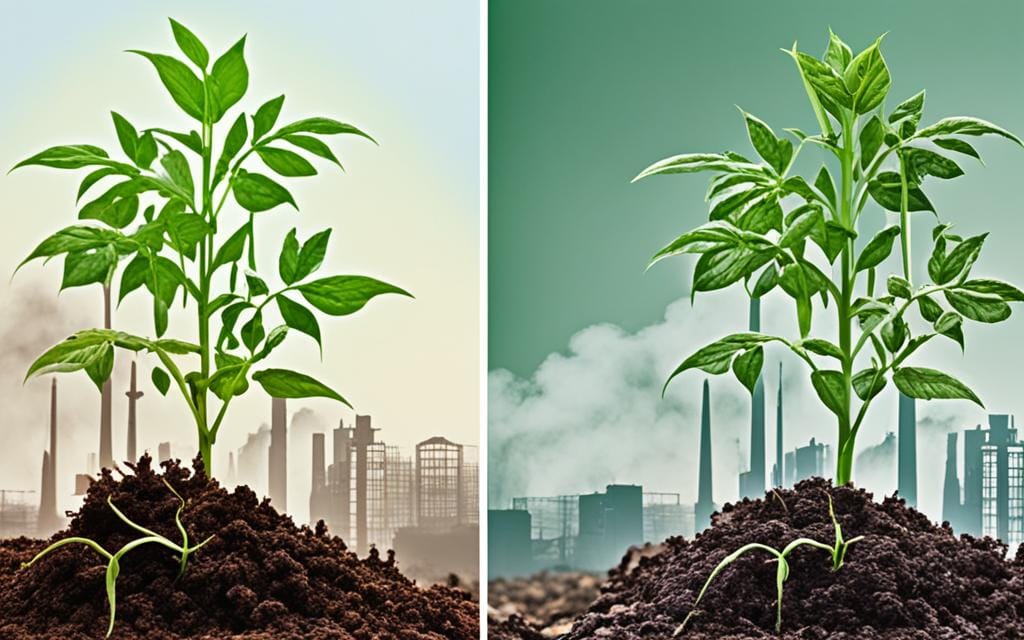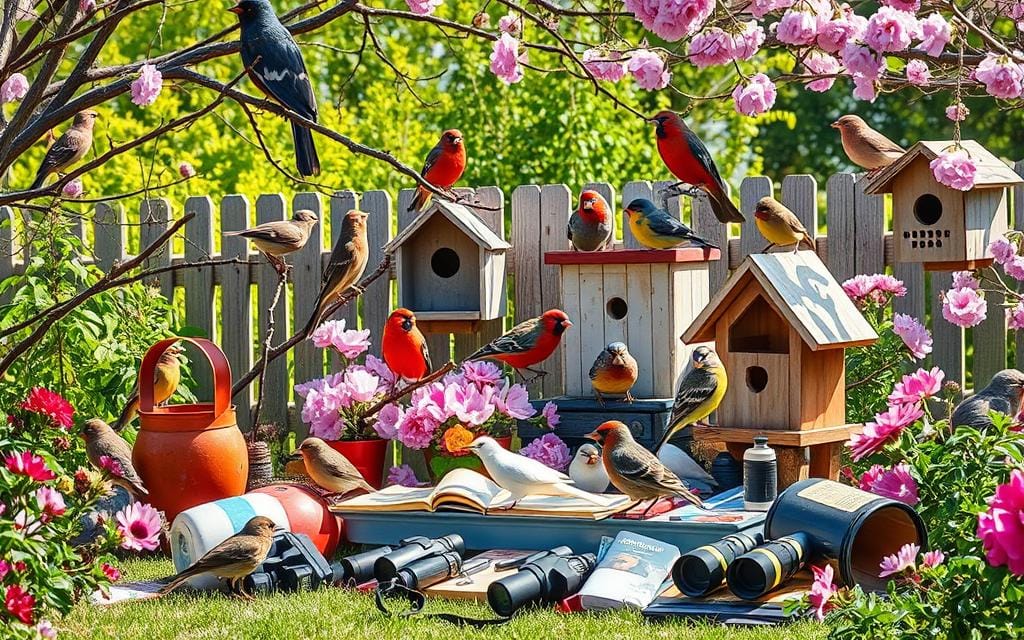Today, we’re focusing on how air pollution impacts plants’ health and growth. We’ll look at how different air pollutants, such as smog, greenhouse gases, ozone, particulate matter, and acid rain, hurt plant life. We’ll check the visible and invisible damages of pollution on different types of plants. This includes crops, ornamental plants, and native ones. Our goal is to explain this important issue clearly.
We’ll also talk about the economic and ecological impacts of air pollution on plants. This involves the work to research and monitor, the laws and rules around it, and educating the public. By learning how air pollution affects plants, we can find ways to help our plant life. This means developing strategies to lessen the harm and keep our plant ecosystems healthy.
Air pollution is a big problem for the planet. It seriously affects the health and energy of plants everywhere. You can see these effects in things like leaves changing color and plants not growing well. But there are also hidden problems, like plants not being able to make their food properly and getting sick easily.
Our aim is to get people to care and take action to save our plants. This is key for protecting our landscapes, both the wild and the ones we farm. Plants are crucial for our world, and we must protect them from air pollution.
Table of Contents
ToggleUnderstanding Air Pollution and Its Impact
We must grasp the sources and kinds of air pollution to see how it harms plants. Both natural and human activities create air pollution. This includes emissions from industries, exhaust from vehicles, and activities like farming. Natural causes, such as volcanoes, add to these pollutants. The main harmful elements for plants are sulfur dioxide (SO2), nitrogen oxides (NOx), ozone (O3), particles in the air (PM), and acid rain.
Sources of Air Pollution
Air pollution comes from natural events like volcanic eruptions, as well as man-made activities. Man-made sources are mainly from industries, transportation, and farming. Burning fossil fuels in power plants and vehicles is a big cause of urban air pollution. These activities also produce gases that lead to the greenhouse effect.
Types of Air Pollutants
Key air pollutants that harm plants are sulfur dioxide (SO2), nitrogen oxides (NOx), ozone (O3), particles in the air (PM), and acid rain. SO2 and NOx can make plant leaves turn brown and even die. Ozone disrupts photosynthesis. PM blocks sunlight and slows plant growth. Acid rain changes the soil’s health, affecting plants in a similar way.
Measuring Air Quality
It’s vital to track and analyze air quality to understand its impact on plants. This is done using various methods, like fixed stations, satellites, and moving sensors. These tools help us determine pollution’s effects on plant life. They are core to creating plans that protect plants from air pollution.
Visible Effects of Air Pollution on Plants
Air pollution directly impacts plants, and we can see these effects easily. Leaf discoloration and cell death, known as necrosis, are two common issues. Plants can get ugly spots, or their leaves might turn yellow or brown, from pollutants like sulfur dioxide and ozone.
Leaf Discoloration and Necrosis
The first signs we see are changes in the plant’s leaves. This happens because the plants can’t photosynthesize properly and their leaf tissues get damaged. Pollutants like sulfur dioxide and ozone mess with the plant’s cells, causing these issues.
Stunted Growth and Deformities
Air pollution doesn’t just change leaf colors; it can make plants smaller or cause them to look strange. The plant might not grow as tall, have odd-shaped leaves, and look weak. This affects how well the plant can survive and how it looks.
These signs tell us there’s a real problem. Seeing these changes helps us know we need to act. By dealing with what we can see, we might help reduce the bigger harm of air pollution on plants and the environment.
Invisible Effects of Air Pollution on Plant Health
Although we can easily see how air pollution harms plants, its hidden effects are just as damaging. The main unseen issue is the harm to photosynthesis. This is how plants use sun, CO2, and water to make energy and food. Pollutants like ozone and nitrogen oxides mess with this process. They lower energy production, making the plants weaker.
Disruption of Photosynthesis
Photosynthesis is very important for plants. When air pollution messes with it, plants suffer. For example, chemicals in the air can hurt the chloroplasts in plant cells. These are the parts that do photosynthesis. As a result, plants cannot turn light into food well. This slows their growth.
Increased Susceptibility to Diseases and Pests
Air pollution does more than just harm photosynthesis. It also makes plants easier targets for diseases and pests. Pollution stresses plants out, weakening their defenses. This lets diseases and bugs attack more easily. As a consequence, plants might die. This can hurt our crops and the beauty of our cities and forests.
how does air pollution affect plants
Air pollution harms plants in many ways, some you see, others you don’t. The primary culprits hurting plant growth and health are:
- Sulfur dioxide (SO2) – Which can turn leaves strange colors, kill them off, and stop growth.
- Nitrogen oxides (NOx) – These pollutants mess up photosynthesis, making plants less lively and productive.
- Ozone (O3) – A strong oxidant that damages plant cells, visibly harming leaves and hurting their overall fitness.
- Particulate matter (PM) – Small particles can cover plant surfaces, blocking light and messing with photosynthesis.
- Acid rain – Rain too acidic can misbalance nutrients, stop growth, and make plants easy targets for pests and diseases.
- Greenhouse gases – Too much carbon dioxide and other gases mess up the whole plant ecosystem and contribute to climate change.
Air pollutants show quick, obvious signs of harm or more hidden, long-term effects. Knowing how pollutants affect plants is key to saving nature. It helps in finding ways to fight air pollution and protect our green planet.
Air Pollution’s Impact on Specific Plant Species
Air pollution affects plants, but not all in the same way. The effects vary from species to species. It’s important to know which plants are most at risk. This helps us understand the overall harm to plant life.
Sensitivity of Crop Plants
Crop plants are vital for our food. They face big risks from air pollution. Issues like reduced yields and poor quality are common. Some crops, like wheat and rice, suffer more. They need extra care and protection.
Effects on Ornamental Plants
Ornamental plants, such as flowers and trees, lose their beauty to pollution. Ozone and sulfur dioxide harm leaves. This makes them less attractive and valuable. Growth and health problems also occur, making them easy targets for pests.
Impact on Native Vegetation
Native plants are key to natural balance. But, air pollution hurts many. Trees and wildflowers are at risk. This can change entire ecosystems, affecting everything that lives there.
Mitigating Strategies and Solutions
To fight air pollution’s effects on plants, we need a smart plan. One of the best ways is to cut down on emissions. We do this by making rules tougher and using new tech to control what comes out of factories, vehicles, and farms.
Reducing Emissions at the Source
Making the rules stricter for what industries, cars, and farms can release helps plants deal with air pollution. This means making sure they use cleaner fuels, meet high emission standards, and turn to new pollution control tech. With less pollution in the air, plants can breathe easier.
Implementing Air Filtration Systems
Air filtration systems are another key. They can be put in places like greenhouses to keep the air clean around plants. By removing bad stuff like particulate matter and ozone, these systems make the air better for growing plants.
Promoting Green Spaces and Urban Forests
Building and looking after parks, gardens, and city forests is essential. These green areas not only beautify our surroundings but also act as natural filters. They soak up pollutants and provide fresh oxygen, significantly improving the air quality. This helps plants not just survive but thrive in cities and towns.
Economic and Ecological Consequences
Air pollution’s impact on plants reaches far and wide. It affects our economy and nature, causing big problems for people and the environment.
Crop Yield Losses
Air pollution hurts crop production. It damages food crops, making them grow less and produce fewer fruits. This leads to less food, which can make food prices go up and hurt farmers and their workers.
Biodiversity Threats
Plants suffering from air pollution can mess up the balance of nature. Some plants can die out, affecting other life forms. This disrupts habitats, reduces pollinators, and hurts the environment’s overall health.
Environmental Degradation
Air pollution weakens our environment over time. It disrupts how plants use carbon dioxide and release oxygen, making climate change worse. This can also lead to more soil erosion and less water and nutrients, making nature less stable.
| Consequence | Impact | Example |
|---|---|---|
| Crop Yield Losses | Reduced agricultural productivity, increased food prices, and threats to food security | Ozone pollution reducing wheat and soybean yields by 10-20% in the United States |
| Biodiversity Threats | Disruption of ecosystems, loss of habitats, and decline of pollinator populations | Acid rain causing declines in sensitive plant species in the Adirondack Mountains of New York |
| Environmental Degradation | Disruption of global carbon cycle, increased soil erosion, and decreased water retention | Particulate matter from industrial emissions contributing to the degradation of forest ecosystems in the Appalachian region |
Research and Monitoring Efforts
Studying the effects of air pollution on plants is key. This research is global, with experts exploring how pollutants like greenhouse gases and acid rain harm plants. They look at how these substances mess with the growth and health of plants.
Field Studies and Experiments
In field studies and lab tests, scientists check how air pollution affects plants. They focus on all kinds of plants, from those we grow for food and beauty to the ones that grow naturally. They see changes in how plants photosynthesize, take in nutrients, and defend themselves, when exposed to bad air.
Experts work to find out when air pollution really hurts plants. They use experiments to discover the exact levels that cause harm. Knowing this helps them find ways to protect plants from getting hurt by air pollution. It’s all about keeping our plant life going strong.
Remote Sensing and Data Analysis
Besides direct studies, scientists are turning to remote sensing and data analysis. This means using tools like satellites and special sensors to watch over plants from far away. They keep an eye on how different plants and forests are doing.
Adding on-the-ground measurements to this remote data helps experts make big pictures. They use all this info to guess what pollution might do to plants in the future. This helps make choices that can keep the Earth’s greenery safe and healthy.
Legal and Regulatory Frameworks
Governments and international groups have set up rules to deal with air pollution’s effects on plant life. They aim to create standards and guidelines. These help restrict how much air pollution can be released. The goal is to protect the environment, especially plant ecosystems.
National and International Standards
Countries have their own air quality standards. These set limits on pollutants like sulfur dioxide and ozone. They help keep people and the planet healthy. Global groups like the World Health Organization (WHO) and the United Nations Environment Programme (UNEP) work together. They create guidelines for fighting air pollution worldwide.
Emission Control Policies
Besides these standards, countries also have policies to control emissions. They aim to reduce pollution from factories, cars, and farms. These policies include setting emission limits and supporting clean tech. There are also reward programs and checks to make sure rules are followed. This helps lessen the harm to plants and the ecosystem.
| National Air Quality Standards | International Air Quality Guidelines |
|---|---|
|
|
Public Awareness and Education
Air pollution impacts plants greatly. It’s vital to tackle this issue through technology and rules. Yet, it’s equally important to inform and educate the public. Engaging the public helps them understand why we should care about plant health. This includes facing the air quality challenges like city smog, greenhouse gases, and acid rain.
Raising Awareness Through Campaigns
Well-designed campaigns are key in showing how air pollution hurts plants. These efforts use various media, outreach programs, and events to spread the word. They talk about the harm air pollutants cause, like discoloring leaves and poor plant growth. This makes people aware of the dangers their surroundings face. We can all get involved to help plants and our environment.
Educating Future Generations
Teaching kids about air quality and plants can have a big impact. By adding these topics to school lessons, we help young people understand the issue. They learn in exciting ways, like through trips and activities. This educates them about the links between the air we breathe and plant health. Such knowledge plants the seeds for a greener, healthier future.

Future Outlook and Trends
The future presents promising growth and ongoing obstacles against air pollution’s impact on plants. Tech advancements are key, offering new methods and solutions. These help monitor, lessen, and maybe even reverse pollution’s harm on plants.
Technological Advancements
Technological progress in areas like remote sensing and data analytics are changing how we see and handle air pollution’s effect on plants. With the use of advanced imaging from satellites and aircraft, we can watch and map pollution’s harm to plants over large areas. This, combined with smart data analysis, helps us spot trends, forecast risks, and focus our responses more precisely.
Sustainable Practices and Lifestyle Changes
Apart from tech, adopting sustainable habits and making life changes is vital. Strategies to cut back on greenhouse gases, boost renewable energy, and grow green transportation and industry moves help fight pollution. Also, creating more green areas in cities and saving natural spaces can boost air quality and aid plant life’s strength.
By using tech and living sustainably, we aim for a future where air purity and plant life’s health is in harmony. This protects the key role plants have in our world and our well-being.
FAQ
How does air pollution affect plants?
Air pollution hurts plants in obvious and silent ways. It can cause leaves to change color or die. This makes the plants not grow well. Also, the plants can’t take in sunlight properly. They become weak against sickness and bugs.
What are the main sources of air pollution that can harm plants?
Both nature and people can make the air dirty. This happens through factories, cars, farming, and sometimes volcanoes. Harmful substances like sulfur dioxide and ozone fill the air. They come from things like burning fuel and making goods.
How do specific plant species respond to air pollution?
Plants react to dirty air in their ways. Some can handle it better than others. It depends on the type of plant. Whether it’s a farm plant, a flower, or a tree from the area, each feels the pollution differently.
What are the economic and ecological consequences of air pollution on plants?
The bad effects of dirty air go beyond just hurting plants. They harm crop growth and the diversity of life. This leads to less food and a weaker natural world. It affects how well we live and how healthy nature is.
How are researchers and policymakers addressing the issue of air pollution’s impact on plants?
Fixing the plant problem takes many steps. This includes watching and studying air quality. Also, making rules and ways to reduce the pollution. Scientists and leaders use many tools to find out how pollution upsets plants.
What can individuals do to help mitigate the effects of air pollution on plants?
We all can do our part to fight air pollution. This means backing laws that make the air cleaner. Getting others to know about the issue also helps. Living in ways that don’t spoil the air is another big step. Together, our efforts can aid plants in coping with pollution.









